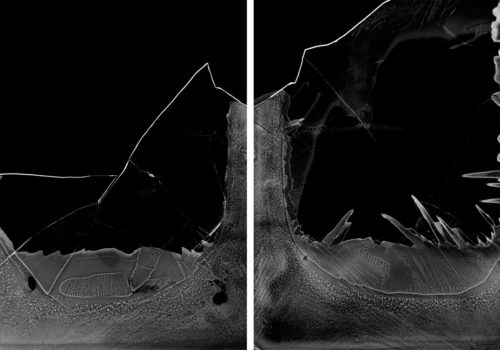Paula McCartney is a patient observer of nature: birds, trees and, more recently, water in its solid state. The latter is on display for a month at the Klompching Gallery in Brooklyn, New York, and serves as a poetic companion to winter’s end. The photographs, only slightly larger than the page of a sketchbook, are gathered in groups: the powdery flakes that form abstract constellations, the ones that looks like the stringy petals of a dandelion, and those that leave white streaks in the night sky.
Among these three geometric variations of snow are visual studies of ice. The abstract portraits reveals the material and sculptural forms of floes, drifts, icebergs, mountains, icicles and other shapes that occur when water freezes. The photographer’s aesthetic is as cold and spare as her subject, winter, and the layout of the exhibition does justice to Paula McCartney’s sophisticated work.
“The layout was done in collaboration with the artist,” says Debra Klomp Ching. The works in the exhibition echo each other as if they were a visual retranscription of their conversation. In the midst of these photographs of snowflakes and other wild flowers whose branches evoke the inherent mathematical aspect of natural elements, the geometry of the ice adds a variable to the equation. The photographer never lets herself be impressed by her subject, even when its size makes one lose all sense of scale. She organizes the pictures by theme and shape, affirming the scientific approach suggested by the title, A Field Guide to Snow and Ice.
As in Rebecca Solnit’s A Field Guide to Getting Lost, Paula McCartney manages to reveals what lies on the other side of the familiar. “Certainly, for artists of all stripes, the unknown, the idea of the form or the tale that has not yet arrived, is what must be found,” writes Solnit, who, like the photographer, grew up in California. “It is the job of artists to open doors and invite prophecies, the unknown, the unfamiliar; it’s where their work comes from, although their arrival signals the beginning of the long disciplined process of making it their own. Scientists too, as J. Robert Oppenheimer once remarked, ‘live always at the edge of mystery — the boundary of the unknown.’ But they transform the unknown into the known, haul it in like fishermen; artists get you out into that dark sea.”
EXHIBITION
A Field Guide to Snow and Ice
Paula McCartney
Through March 29, 2014
Klompching Gallery
111 Front Street
Suite 206
Brooklyn, NY 11201
USA
















